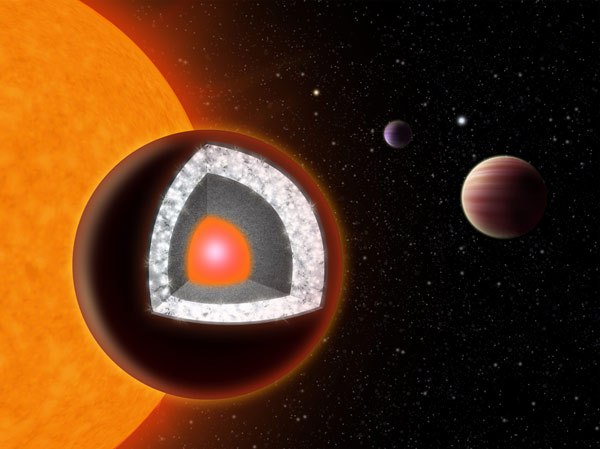
Twinkling stars are not the only diamonds in the sky. Scientists on Thursday reported the existence of a "diamond planet" twice the size of Earth, and eight times its mass, zooming around a nearby star.
 |
|
An illustration showing the planet 55 Cancri e, an extremely hot planet with a surface of mostly graphite surrounding a thick layer of diamond, below which is a layer of silicon-based minerals and a molten iron core at the center. Yale University Handout |
In fact, this is not the first diamond planet ever discovered, but it is the first found orbiting a sun-like star.
The discovery means that distant rocky planets can no longer be assumed to have chemical constituents, interiors, atmospheres, or biological conditions similar to those of Earth, said lead researcher Nikku Madhusudhan, a Yale postdoctoral researcher in physics and astronomy.
The planet was first observed last year — but researchers initially assumed it was similar in its chemical make-up to Earth.
It was only after a more detailed analysis that the French-American research team determined the planet is vastly different from our own.
It "appears to be composed primarily of carbon (as graphite and diamond), iron, silicon carbide and, possibly, some silicates", the authors wrote in a statement ahead of the publication of their findings in the Astrophysical Journal Letters.
"The surface of this planet is likely covered in graphite and diamond rather than water and granite," he explained.
In fact, the planet, dubbed 55 Cancri e, appears to have no water at all. And as much as one-third of the planet‘s substantial mass could be made of diamond, a super-dense compound of carbon.
In comparison, the Earth‘s interior is rich in oxygen and very poor in carbon, explained Kanani Lee, also from Yale and another of the study‘s co-authors.
The researchers estimated the planet‘s radius with data collected while it was transiting in front of its star.
That information, combined with an estimate of its mass, was used to model the planet‘s chemical composition, based on a calculation of just what elements and compounds could result in that specific size and mass.
The planet‘s orbit around its star is lightning fast — a year lasts just 18 hours. And because it is so close to its star, the surface temperatures average 2,148 C, rendering it completely inhospitable to life.
But the planet — 40 light years away from Earth in the Cancer constellation — opens new avenues for studying geochemical and geophysical processes of Earth-sized planets outside our solar system.
The high levels of carbon may have implications for how volcanoes and earthquakes work and how mountains form — and add to the growing body of evidence that planets are far more numerous and varied than initially imagined.
"Stars are simple — given a star‘s mass and age, you know its basic structure and history," said David Spergel, a Princeton University astronomer.
"Planets are much more complex. This 'diamond-rich super-Earth‘ is likely just one example of the rich sets of discoveries that await us as we begin to explore planets around nearby stars."
Agence France-Presse in Washington







